Samegai-juku 醒ケ井宿
|
Title   • File Name • File Name   • Date • Date   • Position • Position   |
|

From Kashiwabara-juku, heading toward Samegai-juku.
|
|
|

Stone marker between Azusa and Kashiwabara-juku.
|
|
|

Kawauchi stone monument
|
|

Nakasendo stone marker. Go left to enter the old Nakasendo Road.
|
|

Nakasendo Road on left, entering Samegai-juku. On the right is Route 21 going to Maibara Station.
|
|

Nakasendo Road going to Samegai-juku.
|
|

Hachiman Shrine
|
|

Site of Ichirizuka milestone on left.
|
|

Ichirizuka milestone 一里塚
|
|
|

Samegai-juku is the sixty-first station or post town (shukuba) of the sixty-nine stations on the Nakasendo Road. It is the second Nakasendo station in Shiga (following Kashiwabara-juku), MAP
|
|
|

Samegai-juku stone monument
|
|

Samegai-juku and Nakasendo Road 醒井宿
|
|
|
|

Kamo Shrine is one of the first things that catches your eye as you enter Samegai. It's shrine on a steep slope. 加茂神社
|
|
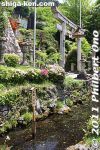
In front of Kamo Shrine is crystal clear water from a natural spring called Isame no Shimizu. This is the source of Samegai's famous Jizogawa River and one of Japan's 100 Famous Springs of the Heisei Period.
|
|

Samegai is famous for its Three Spring Waters and Four Rocks.
|
|

This is one of Samegai's famous Three Spring Waters. This one, in front of Kamo Shrine, is called Isame-no-Kiyomizu. 居醒の清水
|
|

Isame no Shimizu is the natural spring which is the source of Jizogawa River. The name "Samegai" also comes from this spring. 居醒の清水
|
|

About Isame no Shimizu and Yamato Takeru.
|
|
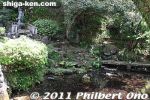
Next to Isame no Shimizu is a statue of Yamato Takeru.
|
|
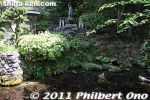
Isame-no-Kiyomizu spring was supposedly where famed warrior Yamato Takeru bathed to heal his wounds after battling an evil boar on Mt. Ibuki.
|
|
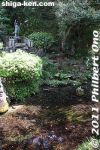
Yamato Takeru was a legendary prince and warrior who traveled a lot and defeated his enemies. However, he met his demise at Mt. Ibuki when he battled an evil god disguised as a white boar.
|
|
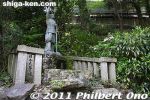
Statue of Yamato Takeru at Samegai's water spring. He defeated the boar, but not before the boar showered him with poisonous rain. He went to Isame no Shimizu whose waters healed him. Then he went on to Ise, but died soon afterward. 日本武尊の�
|
|
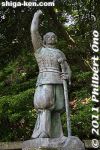
Statue of Yamato Takeru in Samegai-juku's water spring. It is not certain that this was the spring which Yamato Takeru used. Another theory says that he used Tamakurabe Clear Spring in Sekigahara, Gifu.
|
|
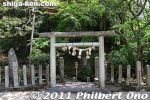
Torii gate to Isame no Shimizu spring waters.
|
|
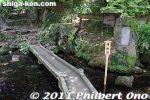
Rock where Yamato Takeru sat.
|
|
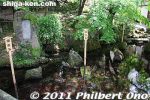
Three of Samegai's famous rocks are here, indicated by these wooden signs. 鞍懸石
|
|
|
|
|
|
|

Jizo-do temple houses a Jizo statue. Originally built by the Ogaki Castle lord Ishikawa Hyuga 石川日向守 in the Edo Period after he recovered from illness. The temple holds the Jizo-bon festival in Aug. 地蔵堂
|
|
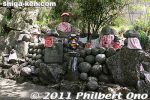
Jizo statues in Samegai. In 817, the priest Saicho carved a Jizo statue in Samegai and prayed for rain during a drought. It then rained heavily for three days. The Jizo was originally placed in the river to prsy for the souls of the fish.
|
|

Crystal-clear Jizogawa River 地蔵川
|
|
|
|
|
|

Jizogawa River was also noted for a freshwater fish called hariyo or stickleback. However, researchers have found that the hariyo seems to have become extinct here by May 2010.
|
|

Samegai Wooden Sculpture Museum, open only on weekends and national holidays. Closed in winter. 醒井木彫美術館
|
|

Site of Honjin lodge. 本陣跡
|
|

Samegai Museum in a former toiya-ba. 米原市醒井宿資料館 醒井宿問屋場(旧川口家住宅)
|
|
|

Inside the former toiya-ba.
|
|

Fire hose
|
|

Jizogawa River was also noted for a freshwater fish called hariyo or stickleback. However, researchers have found that the hariyo seems to have become extinct here by May 2010.
|
|

Apparently someone released a similar species called itoyo into the river and they crossbred. Researchers found the hybrid fish, but no pure-breed hariyo. This has come as a shock to the locals. Hariyo is on Japan's endangered list.
|
|

Underwater baikamo flowers Jizogawa River, Samegai, Shiga Pref. 梅花藻、バイカモ MAP
|
|

Underwater baikamo flowers Jizogawa River, Samegai, Shiga Pref. Bloom in summer, only in very clean water. 梅花藻、バイカモ
|
|

Samegai-juku and Nakasendo Road. The main part of Samegai-juku is near JR Samegai Station on the JR Tokaido Line. Short walk. 醒井宿
|
|
|

Emperor Meiji rested here.
|
|

Monument indicating that Emperor Meiji rested here.
|
|

Samegai Kominkan Community Center
|
|
|
|
|
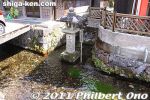
The second of Samegai's famous Three Spring Waters. This one is called Juo-sui. 十王水
|
|
|
|

Samegai Museum in a former post office designed by William Merrell Vories, Samegai, Shiga Pref. 旧醒井郵便局局舎 MAP
|
|
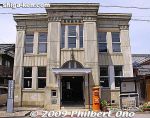
Samegai Museum in a former post office designed by William Merrell Vories, Samegai, Shiga Pref. 旧醒井郵便局局舎 MAP
|
|

Inside post office designed by William Merrell Vories.
|
|

Natural spring called Saigyo-sui. 西行水
|
|

Natural spring called Saigyo-sui. 西行水
|
|

The third of Samegai's famous Three Spring Waters. This one is called Saigyo-sui, named after the famous poet. 西行水
|
|

Saigyo-sui must be clean enough to drink.
|
|
|

Stone marker pointing to Bamba-juku, the next post town.
|
|

Road marker showing the way.
|
|

Tokaido Line train near Samegai.
|
|
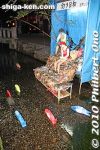
On Aug. 23 and 24, Samegai's Jizo-do temple holds the annual Jizo-bon festival at night. The Nakasendo Road has food stalls and displays of paper mache figures. 地蔵盆
|
|
|
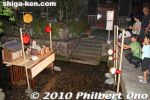
Jizo-bon is held along the Nakasendo road with various displays of paper mache figures made by local school children.
|
|
|
|
|

Jizo-bon in Samegai, Maibara.
|
|
|
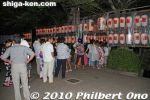
People line up at Jizo-do temple to pray to Jizo.
|
|
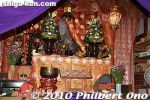
Jizo altar at Jizo-do temple in Samegai, Maibara.
|
|
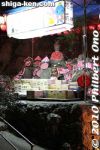
Jizo statues during Jizo-bon.
|
|
|
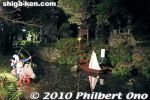
Figures at Isame-no-Kiyomizu spring during Jizo-bon festival.
|
|
|
|
|
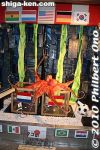
Fortune-telling octopus.
|
|
|

Some displays move.
|
|
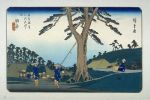
Hiroshige's print of Samegai-juku in his Kisokaido series.
|
|

Samegai Station, on JR Tokaido Line 醒ケ井駅
|
|

Mizunoeki rest house next to Samegai Station
|
|

Exhibition space in Mizunoeki arcade 2nd floor
|
|
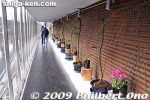
Exhibition space in Mizunoeki
|
|
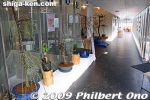
Exhibition in Mizunoeki
|
|
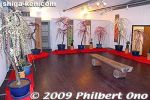
Exhibition in Mizunoeki
|
|

Entrance to Samegai Trout Farm (Yosonjo). Closest train station is JR Samegai Station on the JR Tokaido Line, but there's no public transportation to the trout farm from the train station. There are no taxis either. If you need a ride from Samegai Station, call Omi Taxi Co. at 0749-52-8200 and reserve a taxi at least 1 hour before you want to ride. It's a joint-use taxi, meaning there might be other people in the taxi with you. It also leaves every hour and half hour. The fare is ¥800 per person one way to the trout farm. Another option is to take a taxi from Maibara Station. The ride is longer and will be more expensive.
|
|

Entrance to Samegai Trout Farm (Yosonjo). Established in 1878 and operated by Shiga Prefecture, the Samegai Trout Farm is Asia's largest trout farm with many trout ponds. 醒井養鱒場From JR Samegai Station, it's a one-hour walk.
|
|

The Samegai Trout Farm raises eight types of fish, mainly river fish and trout/salmon species including Biwa salmon, rainbow trout, carp, char, and sturgeon.
|
|

The Samegai Trout Farm raises trout species, perpetuates breeding techniques, researches trout species, and serves as a tourist attraction.
|
|

Trout at Samegai Trout Farm (Yosonjo). The water flows from the Suzuka mountains and it's quite cold which is good for the fish.
|
|
|
|

Trout-catching pond. Kids can freely catch a big trout.
|
|

Look! I caught one!
|
|
|
|
|

Trout fishing for a fee
|
|

Well-known trout restaurant in Samegai Trout Farm called Mimasu.
|
|

Masu trout sushi at Mimasu in Samegai Trout Farm, Shiga Prefecture.
|
|

River along the way to the trout farm.
|
|

Tenjin-sui Natural Spring Park 天神水広場
|
|
|
|

Tenjin-sui Natural Spring Park 天神水広場
|
|

Tenjin-sui Natural Spring with crystal-clear water.
|
|
|

Rainbow trout must be happy to be swimming in such clean water.
|
|
|
|
|
|

In May, a large field of tulips bloom.
|
|

The tulip field is along the road going to the trout farm.
|
|

Since 2004, Kami-nyu in Samegai, Maibara grows tulips every spring for tourists. Kami-nyu Tulip Festival is also held on a Sunday with food booths and stage entertainment.
|
|

Heart of tulips
|
|
|

About 15,000 tulips (+sakura) bloom here. 上丹生チューリップ祭り
|
|
|
|
|
|
|
|

The tulips come in various colors.
|
|
|

Samegai tulips, Maibara, Shiga
|
|
|
|
|
|
|
|
|
|
|
|
|
|
|
|
|
|
|
|
|
|